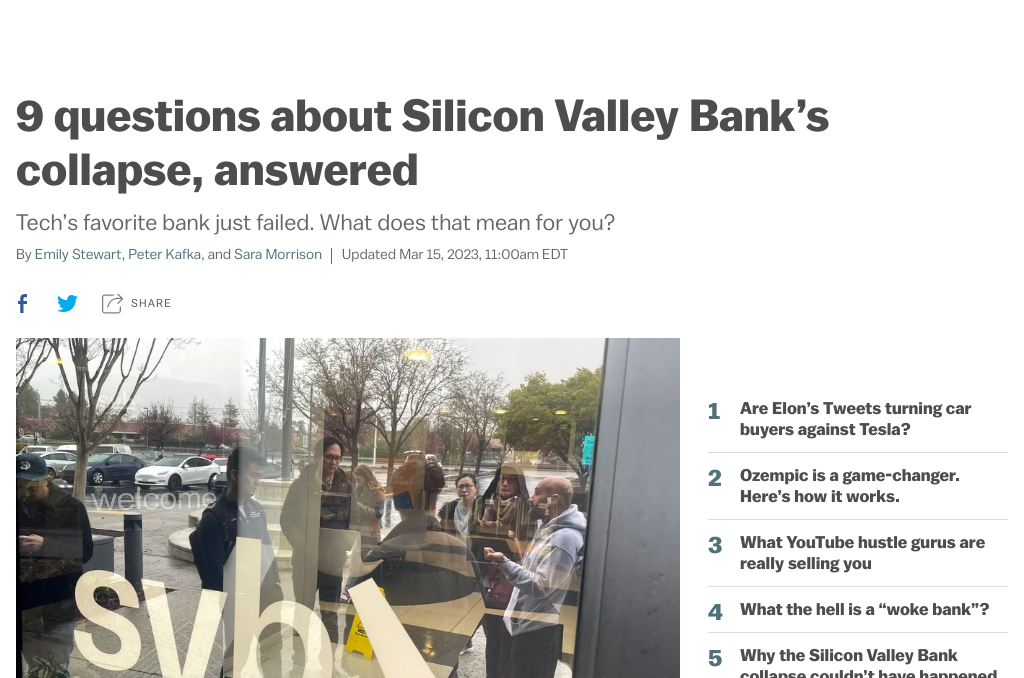Silicon Valley Bank (SVB), the 16th-largest lender in America, collapsed last Friday, setting off a wave of panic in the venture capital and tech startup world.[0] The bank, which had become the go-to lender for nearly half of all venture-backed tech startups and many in the healthcare sector, had over $200 billion in assets and almost 93% of its deposits were uninsured.[1] The Federal Deposit Insurance Corporation (FDIC) quickly seized the bank, though the Federal Reserve and the Treasury Department stepped in to guarantee all deposits.
The collapse of Silicon Valley Bank (SVB) was a long time coming, and was tied closely to the financial infrastructure of the tech industry.[2] Founded in 1983, SVB had become a major player in the world of venture capital, providing loans and services to startups, venture capital firms, and private equity.[3] SVB’s business model was risky, however, as it borrowed short-term, taking in money from depositors, and lent long-term. All banks employ this strategy, but SVB took it too far, too quickly, without any margin of error.[4]
The bank’s predicament was exacerbated by the fact that its deposits were over the $250,000 amount federally guaranteed by the FDIC. When the bank announced a $2.25 billion share sale, its clients panicked and began to withdraw their money. The following night, regulators seized the bank and the FDIC said it would retroactively protect all depositors at the two failed banks, not just smaller, insured, depositors.
President Joe Biden stepped in to reassure Americans that the banking system was sound, and the Federal Reserve and the Treasury Department said that banks facing similar situations—having to sell Treasury securities to meet deposits—could instead borrow from the Fed.[4]
The collapse of Silicon Valley Bank highlights the risks of a concentrated banking system.[5] Though the government stepped in to protect all deposits, uninsured US depositors do, in practice, lose money with some frequency.[6] A 2020 report from economists at the FDIC found that a significant share of bank failures from 1980 to 2013 resulted in uninsured depositors losing some funds.[6] Even those with more than $250,000 deposited were made whole this time, but the Silicon Valley Bank collapse is a reminder that banking oversight is essential in order to protect depositors from potential losses.[7]
0. “How does a bank collapse in 48 hours? A timeline of the SVB fall” CNN, 13 Mar. 2023, https://www.cnn.com/2023/03/11/business/svb-bank-collapse-explainer-timeline/index.html
1. “‘Lungs of the startup world’: bank fall upends most Silicon Valley industries” The Guardian, 15 Mar. 2023, https://www.theguardian.com/technology/2023/mar/15/silicon-valley-bank-failure-industries-investors-rattled
2. “What is Silicon Valley Bank? The bank’s collapse, explained.” Vox.com, 10 Mar. 2023, https://www.vox.com/technology/23634433/silicon-valley-bank-collapse-silvergate-first-republic-fdic
3. “Silicon Valley Bank’s failure, the government’s depositor rescue, and venture capitalists’ incredible tantrum.” Slate, 13 Mar. 2023, https://slate.com/technology/2023/03/silicon-valley-bank-rescue-venture-capital-calacanis-sacks-ackman-tantrum.html
4. “Silicon Valley Bank: Who’s to Blame?” City Journal, 13 Mar. 2023, https://www.city-journal.org/silicon-valley-bank-who-is-to-blame
5. “Silicon Valley Bank collapse sets tech industry up for bigger crisis” Business Insider, 15 Mar. 2023, https://www.businessinsider.com/silicon-valley-banks-collapse-tech-venture-capital-industry-bigger-crisis-2023-3
6. “The Silicon Valley Bank collapse couldn’t have happened in this one state” Vox.com, 15 Mar. 2023, https://www.vox.com/policy/23636583/silicon-valley-bank-collapse-fdic-deposit-massachusetts
7. “Opinion | How Bad Was the Silicon Valley Bank Bailout?” The New York Times, 14 Mar. 2023, https://www.nytimes.com/2023/03/14/opinion/silicon-valley-bank-bailout.html
